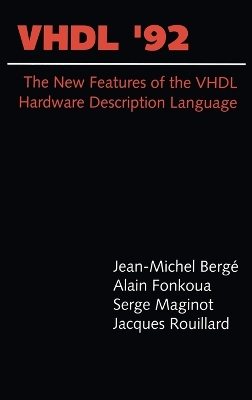The Springer International Series in Engineering and Computer Science
1 primary work • 2 total works
Book 261
Circuit Synthesis with VHDL
by Roland Airiau, Jean-Michel Berge, and Vincent Olive
Published 28 February 1994
One of the main applications of VHDL is the synthesis of electronic circuits. Circuit Synthesis with VHDL is an introduction to the use of VHDL logic (RTL) synthesis tools in circuit design. The modeling styles proposed are independent of specific market tools and focus on constructs widely recognized as synthesizable by synthesis tools.
A statement of the prerequisites for synthesis is followed by a short introduction to the VHDL concepts used in synthesis. Circuit Synthesis with VHDL presents two possible approaches to synthesis: the first starts with VHDL features and derives hardware counterparts; the second starts from a given hardware component and derives several description styles. The book also describes how to introduce the synthesis design cycle into existing design methodologies and the standard synthesis environment.
Circuit Synthesis with VHDL concludes with a case study providing a realistic example of the design flow from behavioral description down to the synthesized level.
Circuit Synthesis with VHDL is essential reading for all students, researchers, design engineers and managers working with VHDL in a synthesis environment.
A statement of the prerequisites for synthesis is followed by a short introduction to the VHDL concepts used in synthesis. Circuit Synthesis with VHDL presents two possible approaches to synthesis: the first starts with VHDL features and derives hardware counterparts; the second starts from a given hardware component and derives several description styles. The book also describes how to introduce the synthesis design cycle into existing design methodologies and the standard synthesis environment.
Circuit Synthesis with VHDL concludes with a case study providing a realistic example of the design flow from behavioral description down to the synthesized level.
Circuit Synthesis with VHDL is essential reading for all students, researchers, design engineers and managers working with VHDL in a synthesis environment.
v. 229
VHDL '92
by Jean-Michel Berge, etc., Alain Fonkoua, Serge Maginot, and Jacques Rouillard
Published 30 June 1993
An open process of restandardization, conducted by the IEEE, has led to the definitions of the new VHDL standard. The changes make VHDL safer, more portable, and more powerful. VHDL also becomes bigger and more complete. The canonical simulator of VHDL is enriched by new mechanisms, the predefined environment is more complete, and the syntax is more regular and flexible. Discrepancies and known bugs of VHDL'87 have been fixed. However, the new VHDL'92 is compatible with VHDL'87, with some minor exceptions. This book presents the new VHDL'92 for the VHDL designer. New features are explained and classified. Examples are provided, each new feature is given a rationale and its impact on design methodology, and performance is analyzed. Where appropriate, pitfalls and traps are explained. The VHDL designer should quickly be able to find the feature needed to evaluate the benefits it brings, to modify previous VHDL'87 code to make it more efficient, more portable, and more flexible. This text should be a useful update for all VHDL designers and managers involved in electronic design.

